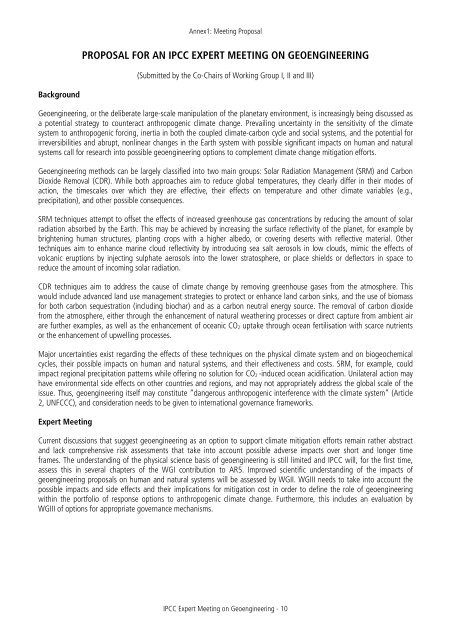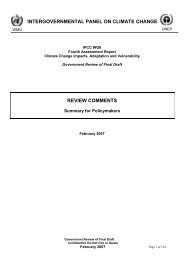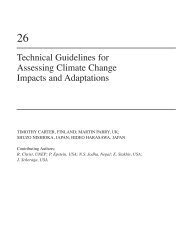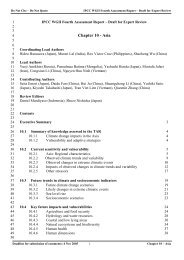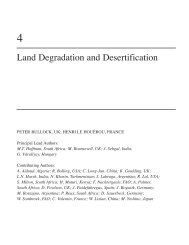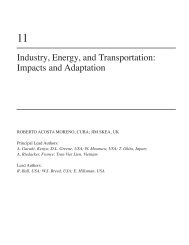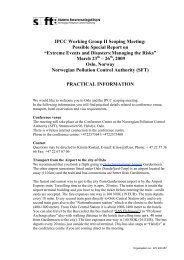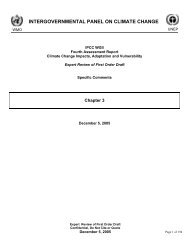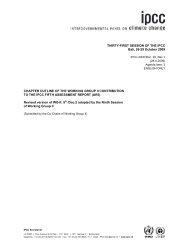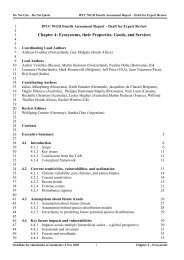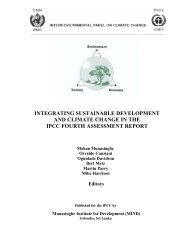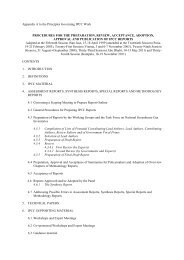IPCC Expert Meeting on Geoengineering
IPCC Expert Meeting on Geoengineering
IPCC Expert Meeting on Geoengineering
Create successful ePaper yourself
Turn your PDF publications into a flip-book with our unique Google optimized e-Paper software.
Annex1: <str<strong>on</strong>g>Meeting</str<strong>on</strong>g> Proposal<br />
PROPOSAL FOR AN <str<strong>on</strong>g>IPCC</str<strong>on</strong>g> EXPERT MEETING ON GEOENGINEERING<br />
(Submitted by the Co-Chairs of Working Group I, II and III)<br />
Background<br />
<strong>Geoengineering</strong>, or the deliberate large-scale manipulati<strong>on</strong> of the planetary envir<strong>on</strong>ment, is increasingly being discussed as<br />
a potential strategy to counteract anthropogenic climate change. Prevailing uncertainty in the sensitivity of the climate<br />
system to anthropogenic forcing, inertia in both the coupled climate-carb<strong>on</strong> cycle and social systems, and the potential for<br />
irreversibilities and abrupt, n<strong>on</strong>linear changes in the Earth system with possible significant impacts <strong>on</strong> human and natural<br />
systems call for research into possible geoengineering opti<strong>on</strong>s to complement climate change mitigati<strong>on</strong> efforts.<br />
<strong>Geoengineering</strong> methods can be largely classified into two main groups: Solar Radiati<strong>on</strong> Management (SRM) and Carb<strong>on</strong><br />
Dioxide Removal (CDR). While both approaches aim to reduce global temperatures, they clearly differ in their modes of<br />
acti<strong>on</strong>, the timescales over which they are effective, their effects <strong>on</strong> temperature and other climate variables (e.g.,<br />
precipitati<strong>on</strong>), and other possible c<strong>on</strong>sequences.<br />
SRM techniques attempt to offset the effects of increased greenhouse gas c<strong>on</strong>centrati<strong>on</strong>s by reducing the amount of solar<br />
radiati<strong>on</strong> absorbed by the Earth. This may be achieved by increasing the surface reflectivity of the planet, for example by<br />
brightening human structures, planting crops with a higher albedo, or covering deserts with reflective material. Other<br />
techniques aim to enhance marine cloud reflectivity by introducing sea salt aerosols in low clouds, mimic the effects of<br />
volcanic erupti<strong>on</strong>s by injecting sulphate aerosols into the lower stratosphere, or place shields or deflectors in space to<br />
reduce the amount of incoming solar radiati<strong>on</strong>.<br />
CDR techniques aim to address the cause of climate change by removing greenhouse gases from the atmosphere. This<br />
would include advanced land use management strategies to protect or enhance land carb<strong>on</strong> sinks, and the use of biomass<br />
for both carb<strong>on</strong> sequestrati<strong>on</strong> (including biochar) and as a carb<strong>on</strong> neutral energy source. The removal of carb<strong>on</strong> dioxide<br />
from the atmosphere, either through the enhancement of natural weathering processes or direct capture from ambient air<br />
are further examples, as well as the enhancement of oceanic CO 2 uptake through ocean fertilisati<strong>on</strong> with scarce nutrients<br />
or the enhancement of upwelling processes.<br />
Major uncertainties exist regarding the effects of these techniques <strong>on</strong> the physical climate system and <strong>on</strong> biogeochemical<br />
cycles, their possible impacts <strong>on</strong> human and natural systems, and their effectiveness and costs. SRM, for example, could<br />
impact regi<strong>on</strong>al precipitati<strong>on</strong> patterns while offering no soluti<strong>on</strong> for CO 2 -induced ocean acidificati<strong>on</strong>. Unilateral acti<strong>on</strong> may<br />
have envir<strong>on</strong>mental side effects <strong>on</strong> other countries and regi<strong>on</strong>s, and may not appropriately address the global scale of the<br />
issue. Thus, geoengineering itself may c<strong>on</strong>stitute “dangerous anthropogenic interference with the climate system” (Article<br />
2, UNFCCC), and c<strong>on</strong>siderati<strong>on</strong> needs to be given to internati<strong>on</strong>al governance frameworks.<br />
<str<strong>on</strong>g>Expert</str<strong>on</strong>g> <str<strong>on</strong>g>Meeting</str<strong>on</strong>g><br />
Current discussi<strong>on</strong>s that suggest geoengineering as an opti<strong>on</strong> to support climate mitigati<strong>on</strong> efforts remain rather abstract<br />
and lack comprehensive risk assessments that take into account possible adverse impacts over short and l<strong>on</strong>ger time<br />
frames. The understanding of the physical science basis of geoengineering is still limited and <str<strong>on</strong>g>IPCC</str<strong>on</strong>g> will, for the first time,<br />
assess this in several chapters of the WGI c<strong>on</strong>tributi<strong>on</strong> to AR5. Improved scientific understanding of the impacts of<br />
geoengineering proposals <strong>on</strong> human and natural systems will be assessed by WGII. WGIII needs to take into account the<br />
possible impacts and side effects and their implicati<strong>on</strong>s for mitigati<strong>on</strong> cost in order to define the role of geoengineering<br />
within the portfolio of resp<strong>on</strong>se opti<strong>on</strong>s to anthropogenic climate change. Furthermore, this includes an evaluati<strong>on</strong> by<br />
WGIII of opti<strong>on</strong>s for appropriate governance mechanisms.<br />
<str<strong>on</strong>g>IPCC</str<strong>on</strong>g> <str<strong>on</strong>g>Expert</str<strong>on</strong>g> <str<strong>on</strong>g>Meeting</str<strong>on</strong>g> <strong>on</strong> <strong>Geoengineering</strong> - 10


